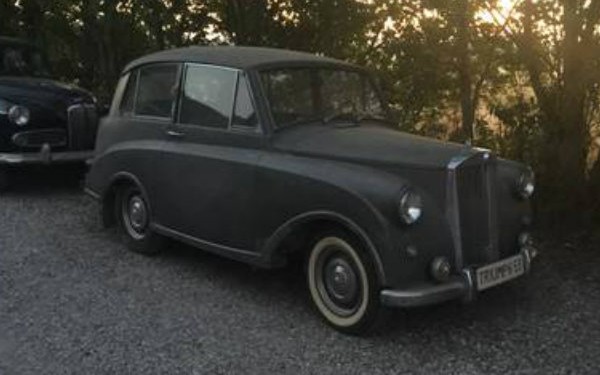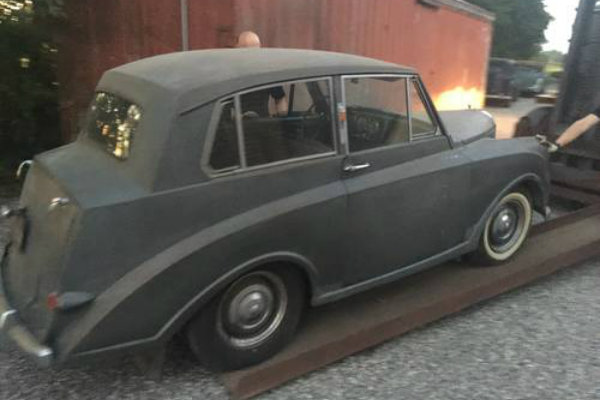This Triumph Mayflower is an example of a car designed for the American market (thus the name) by a company that really didn’t have a handle on what Americans wanted. While much of the production ended up on this side of the ocean, this particular car is for sale in Copenhagen, Denmark for 5,000 British pounds here on Car And Classic.
I thought I’d include a picture of what a nice Mayflower looks like–the two-tone really shows off the “miniature limousine” body lines. The British called this type of styling “razor-edge,” and it’s essentially mimicking the larger Triumph saloons of the time such as the 1800, 2000, and Renown, but on a smaller scale.
Despite being relatively practical and having a surprising amount of inside space for such a small car, very few purchasers were found. The car was quickly discontinued after four years in 1953, making this one titled as a 1954 probably one of the last cars that was left on a lot and titled in the year of purchase. This one seems to be in relatively solid shape body-wise, but the clutch and brakes don’t work.
The interior is typical for a British car of the time, and I think I recognize those door and window handles as being the same as used on my Mk. 2 Spitfire almost 13 years later. A Mayflower, in what looks to be largely original condition, is hard to come by; the hydraulic components are available from specialist suppliers or eBay in the UK so there’s no excuse for not getting it back on the road. Would you paint it two tone, or go back with the original black, or maybe just drive it as-is?






I have seen very few of these — never mind that I am almost the same age as they are — but have always thought them amusing. “Razor-edge” design works well on, say, a Rolls-Royce of the period, but less well on a very compact two-door.
Word is they are abysmally slow as well, which always led me to think one would be a good candidate for an engine swap! But if I were to buy one, I think I’d restore it, and probably in nice, somber black. Or, if I was feeling adventurous, perhaps a two-tone black/gray.
Good thing it’s so far away. I could look at Ferraris daily and resist temptation, but oddball cars like this always seem to scream “take me home!”
One can easily argue that Mayflowers were underpowered, but so was pretty much everything in its class at the time. What makes the Mayflower a “challenge” to drive is the fact that the gearbox had only three forward speeds (all synchro), and the gap between 1st and 2nd was big enough to drive the proverbial truck through. It might have been a better driving car for Americans if it had that extra gear, but more importantly if it had, say, a sleeved-down version of the wet-liner Vanguard engine (something like the 1670cc version used in late 1950s and early 1960s Standard Ensigns).
Beyond all that, styling is what it was, and you liked it or didn’t. In fairness, Mayflower to Renown is somewhat akin to AMC Gremlin to Hornet. ;)
And beyond all THAT, it makes a great around-town car and a helluva conversation-starter!
My folks had a black one of these as a loan car when our 1950 Country Squire was in the body shop, in 1953.
And? What was their opinion of it?
My parents had one of these in the late fifties – could not afford anything better for my mother to drive. Until, that is, going around a fairly normal corner the rear door flew open and I, sitting in the back seat (without a seat belt of course) almost went out onto the street. The car was traded shortly thereafter for another abysmal British car, a Hillman Minx, which at least had the good grace to run decently and with evidently better body hardware than the unlamented Triumph. As a car crazed kid, I knew these were both incredibly slow cars, compared to even the relatively dull American cars most suburban families owned in the late fifties (mostly used four door sedans and station wagons, any of which could leave a Triumph Mayflower in the rear view mirror with ease).
David: If it was the rear door that opened, it wasn’t a Mayflower, as they only made them in 2-door saloons. It’s so damn hard to get in & out of the rear seat of a Mayflower, even a child, that I suspect you were in a Triumph Renown. They had a similar look with the “razor-edge” style, but bigger and with 4-doors. [Looks like a smaller version of the Bentley Mk6.]
If it was in the USA, Standard [the parent company of Triumph] sold their Standard 8 and 10 series cars as Triumphs, but these were the rounded body style popular at the time, and also the basis for the mechanicals used in the new TR2 sports car.
Bill, it was actually the Mayflower that lent essentially its front suspension and some other drivetrain bits (after a fashion, since some Vanguard bits mingled in as well) to the TR2.(Thankfully, the Mayflower’s tiny flathead wasn’t part of that.)
Evolution of much of the Standard 8 and 10 (Triumph 10 in the US) formed the mechanical basis of the Triumph Herald, which in turn led rather directly to the Spitfire!
You cant have had one of these as they never had back doors only 2.
The two tone version looks fantastic, very classie. In my younger days when I was still working as an auto mechanic I didn’t get the opportunity to work on British cars to often as there weren’t to many around in my area, so I have to ask you guys that have the experience. Is it not possible to transplant an engine, transmission, and over drive attachment out of an Austin into this car to help it move a little faster? Anyone care to chime in? As for the colour, red over black with a red leather interior. I think that between the transplant and the finish this could be a show stopper.
…another lesson on an auto that I never knew existed…thanks BF
and (being from Plymouth, Massachusetts), it’s about the same size as the original Mayflower vessel used by the Puritans….
The ship was faster!
I first heard the expression “couldn’t pull the skin off a rice pudding” to describe how slow one of these cars really is. Plenty around in England in their day, and always the car you got stuck behind. Most Uk cars of the time could leave it for dead, if slowly. Even Austin Devons were much quicker. I have seen Mayflowers customised with more power in magazines. If it would fit, a Mondeo zetec 2.0litre, with its standard 130 bhp would make this car into something special. To handle that brakes suspension steering etc would be essential. An auto box possibly from a 2.0litre Granada would hook up to that nicely. Just my imagination running!
I had one of these back in the 1980s, I loved the looks, and parked next to my 1952 Rolls-Royce Silver Dawn it made the Dawn look like a silver Wraith limo! As I recall, it had an 800cc engine, but little room for much else due to the car’s size.
Richard Langworth published a wonderful poster years ago, showing a Mayflower parked in front of a large mansion. The Text at the bottom of the poster was:
The Triumph Mayflower: It makes your house look bigger!
I’ve wanted a Mayflower for ages! Somewhere I have a test drive article, I think by Motor Trend of this versus several other popular small cars of the day. I generally would avoid old British cars like the plague but for some reason Mayflowers always appealed to me. Probably because I love small weird cars. I recall somewhere seeing a Mayflower a guy had swapped an MGB drivetrain into, wire wheels and all!
I had one when I was sixteen in Ontario Canada. Great little car for a student. Four cylindar flathead but so slow. Mine was a fifty two in dark green
A great place to look for brake parts and lots of other Triumph parts is Moss Motors. I was able to purchase brand new ( NOT refurbished ! ) calipers and master cylinder for my TR-6 at reasonable prices, and delivery was very prompt.
Also, The Roadster Factory carries an extensive line for the sports cars, and many of the mechanicals and chassis components are compatible.
As a Yank (note my age at 77) I have owned two of the vehicles, the first my earliest purchase in San Francisco 1966, and our delight. The engine swap had been done to an Austin A40 with 4-speed trans on the floor, but otherwise it was in good shape bar rust and some missing bits. On my discharge in 68 I drove it daily to SF to work from our rental in Mountain View, and the engine failed. I sold it for 60 dollars, which was not close to a used anything else, so ended my job there and went back to Colorado. No matter what, my wife, two children and I were always greeted with ‘hey, what is that?!’ even at the license office where my wife drove it to a general turnout of inspectors. Our second was a basket case that rolled when the rear end locked being towed home, and was later sold to a hot rodder who extended its nose for a V8, and which I still regret not holding on to. It was fun, interesting, and I got very good at fixing things…